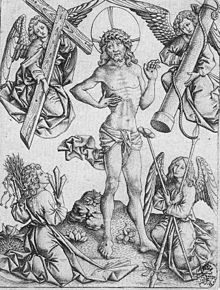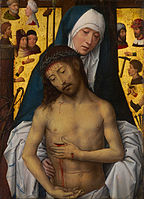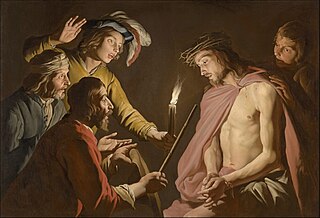
The Passion is the short final period before the death of Jesus, described in the four canonical gospels. It is commemorated in Christianity every year during Holy Week.
A number of alleged relics associated with Jesus have been displayed throughout the history of Christianity. While some individuals believe in the authenticity of Jesus relics, others doubt their validity. For instance, the sixteenth-century philosopher Erasmus wrote about the proliferation of relics, and the number of buildings that could be constructed from wooden relics claimed to be from the crucifixion cross of Jesus. Similarly, at least thirty Holy Nails were venerated as relics across Europe in the early 20th century. Part of the relics are included in the so-called Arma Christi, or the Instruments of the Passion.

The Holy Sponge is one of the Instruments of the Passion of Jesus. It was dipped in vinegar, most likely posca, a regular beverage of Roman soldiers, and offered to Jesus to drink from during the Crucifixion, according to Matthew 27:48, Mark 15:36, and John 19:29.

Man of Sorrows, a biblical term, is paramount among the prefigurations of the Messiah identified by the Bible in the passages of Isaiah 53 in the Hebrew Bible. It is also an iconic devotional image that shows Christ, usually naked above the waist, with the wounds of his Passion prominently displayed on his hands and side, often crowned with the Crown of Thorns and sometimes attended by angels. It developed in Europe from the 13th century and was especially popular in Northern Europe.

Relics that are claimed to be the Holy Nails with which Jesus was crucified are objects of veneration among some Christians, particularly Roman Catholics and the Eastern Orthodox. In Christian symbolism and art, they figure among the Arma Christi or Instruments of the Passion, the objects associated with the Passion of Jesus. Like the other Instruments, the Holy Nails have become an object of veneration among many Christians and have been pictured in paintings.

A doubting Thomas is a skeptic who refuses to believe without direct personal experience – a reference to the Gospel of John's depiction of the Apostle Thomas, who, in John's account, refused to believe the resurrected Jesus had appeared to the ten other apostles until he could see and feel Jesus's crucifixion wounds.

In Catholic tradition, the Five Holy Wounds, also known as the Five Sacred Wounds or the Five Precious Wounds, are the five piercing wounds that Jesus Christ suffered during his crucifixion. The wounds have been the focus of particular devotions, especially in the late Middle Ages, and have often been reflected in church music and art.

Ecce homo are the Latin words used by Pontius Pilate in the Vulgate translation of the Gospel of John, when he presents a scourged Jesus, bound and crowned with thorns, to a hostile crowd shortly before his Crucifixion. The original New Testament Greek: "ἰδοὺ ὁ ἄνθρωπος", romanized: "idoù ho ánthropos", is rendered by most English Bible translations, e.g. the Douay-Rheims Bible and the King James Version, as "behold the man". The scene has been widely depicted in Christian art.

The Descent from the Cross, or Deposition of Christ, is the scene, as depicted in art, from the Gospels' accounts of Joseph of Arimathea and Nicodemus taking Christ down from the cross after his crucifixion. In Byzantine art the topic became popular in the 9th century, and in the West from the 10th century. The Descent from the Cross is the 13th Station of the Cross, and is also the sixth of the Seven Sorrows of the Blessed Virgin Mary.
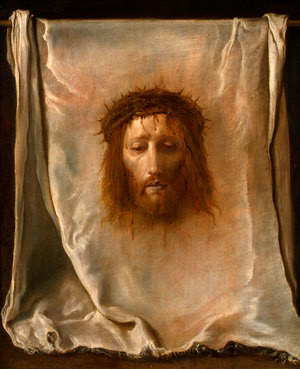
Andachtsbilder is a German term often used in English in art history for Christian devotional images designed as aids for prayer or contemplation. The images "generally show holy figures extracted from a narrative context to form a highly focused, and often very emotionally powerful, vignette".
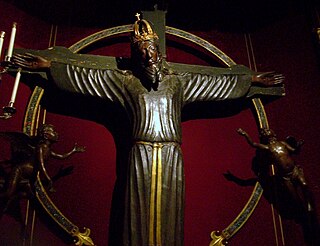
The Holy Face of Lucca is an eight-foot-tall (2.4 m), ancient wooden carving of Jesus crucified in the cathedral of San Martino, Lucca, Italy. Medieval legends state that it was sculpted by Nicodemus who assisted St. Joseph of Arimathea in placing Christ in his tomb after the crucifixion. The same legends placed its miraculous arrival in Lucca to AD 782.

The Pensive Christ is a subject in Christian iconography depicting a contemplating Jesus, sitting with his head supported by his hand with the Crown of Thorns and marks of his flagellation. It is, therefore, a picture of Jesus shortly before his crucifixion, although more an andachtsbild or devotional subject than intended to show an actual moment in the narrative of the Passion of Christ. The Pensive Christ is much more common in sculpture than in painting, where the similar Man of Sorrows is more often depicted.

The Flagellation of Christ, in art sometimes known as Christ at the Column or the Scourging at the Pillar, is an episode from the Passion of Jesus as presented in the Gospels. As such, it is frequently shown in Christian art, in cycles of the Passion or the larger subject of the Life of Christ. Catholic tradition places the Flagellation at the beginning of Via Dolorosa in Jerusalem, and the modern alternate Stations of the Cross locate it at the fourth station; it represents a Sorrowful Mystery of the Rosary. The column to which Christ is normally shown to be tied, and the rope, scourge, whip or birch are elements in the Arma Christi. The Basilica di Santa Prassede in Rome is one of the churches claiming to possess the original column or parts of it.

The Lamentation of Christ is a very common subject in Christian art from the High Middle Ages to the Baroque. After Jesus was crucified, his body was removed from the cross and his friends mourned over his body. This event has been depicted by many different artists.

The life of Christ as a narrative cycle in Christian art comprises a number of different subjects showing events from the life of Jesus on Earth. They are distinguished from the many other subjects in art showing the eternal life of Christ, such as Christ in Majesty, and also many types of portrait or devotional subjects without a narrative element.

The Descent from the Cross is a panel painting by the Flemish artist Rogier van der Weyden created c. 1435, now in the Museo del Prado, Madrid. The crucified Christ is lowered from the cross, his lifeless body held by Joseph of Arimathea and Nicodemus.

The Mass of Saint Gregory is a subject in Roman Catholic art which first appears in the late Middle Ages and was still found in the Counter-Reformation. Pope Gregory I is shown saying Mass just as a vision of Christ as the Man of Sorrows has appeared on the altar in front of him, in response to the Pope's prayers for a sign to convince a doubter of the doctrine of transubstantiation.

Crucifixions and crucifixes have appeared in the arts and popular culture from before the era of the pagan Roman Empire. The crucifixion of Jesus has been depicted in a wide range of religious art since the 4th century CE, frequently including the appearance of mournful onlookers such as the Virgin Mary, Pontius Pilate, and angels, as well as antisemitic depictions portraying Jews as responsible for Christ's death. In more modern times, crucifixion has appeared in film and television as well as in fine art, and depictions of other historical crucifixions have appeared as well as the crucifixion of Christ. Modern art and culture have also seen the rise of images of crucifixion being used to make statements unconnected with Christian iconography, or even just used for shock value.

Man of Sorrows is a small Early Netherlandish oil on wood panel painting completed c. 1485–1495. It is attributed to Geertgen tot Sint Jans and in the tradition of the devotional images of the "Man of Sorrows", which typically show Christ before his crucifixion, naked above the waist, bearing the wounds of his Passion. The panel has an unusually complex and suffocating spatial design, and depicts the mocking of Jesus, and his grieving mother. The panel is steeped in both complex iconography and deep pathos. Christ is in obvious pain and holds his wounds up for the viewer. He looks out while white robed weeping angels bear the Arma Christi -objects associated with his crucifixion and death- float around him. The attending saints include Mary and the Magdalene.

The Man of Sorrows is a tempera and oil on panel painting of Jesus Christ by the Florentine artist Sandro Botticelli (1445-1510), thought to have been painted sometime between 1500 and 1510.
